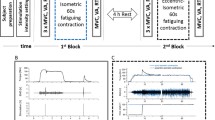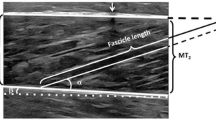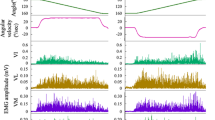Abstract
Force enhancement during and following muscle stretch has been observed for electrically and voluntarily activated human muscle. However, especially for voluntary contractions, the latter observation has only been made for adductor pollicis and the ankle joint muscles, but not for large muscles like quadriceps femoris. Therefore, the aim of this study was to investigate the effects of active muscle stretch on force production for maximal voluntary contractions of in vivo human quadriceps femoris (n = 15). Peak torques during and torques at the end of stretch, torques following stretch, and passive torques following muscle deactivation were compared to the isometric torques at corresponding muscle length. In addition, muscle activation of rectus femoris, vastus medialis and vastus lateralis was obtained using surface EMG. Stretches with different amplitudes (15, 25 and 35° at a velocity of 60° s−1) were performed on the plateau region and the descending limb of the force–length relation in a random order. Data analysis showed four main results: (1) peak torques did not occur at the end of the stretch, but torques at the end of the stretch exceeded the corresponding isometric torque; (2) there was no significant force enhancement following muscle stretch, but a small significant passive force enhancement persisted for all stretch conditions; (3) forces during and following stretch were independent of stretch amplitude; (4) muscle activation during and following muscle stretch was significantly reduced. In conclusion, although our results showed passive force enhancement, we could not provide direct evidence that there is active force enhancement in voluntarily activated human quadriceps femoris.





Similar content being viewed by others
References
Babault N, Pousson M, Ballay Y, Van Hoecke J (2001) Activation of human quadriceps femoris during isometric, concentric, and eccentric contractions. J Appl Physiol 91:2628–2634
Bagni MA, Cecchi G, Colombini B, Colomo F (2002) A non-cross-bridge stiffness in activated frog muscle fibers. Biophys J 82:3118–3127
Beltman JG, Sargeant AJ, van Mechelen W, de Haan A (2004) Voluntary activation level and muscle fiber recruitment of human quadriceps during lengthening contractions. J Appl Physiol 97:619–626
De Ruiter CJ, Didden WJ, Jones DA, Haan AD (2000) The force–velocity relationship of human adductor pollicis muscle during stretch and the effects of fatigue. J Physiol 526(Pt 3):671–681
Dudley GA, Harris RT, Duvoisin MR, Hather BM, Buchanan P (1990) Effect of voluntary vs. artificial activation on the relationship of muscle torque to speed. J Appl Physiol 69:2215–2221
Edman KA, Elzinga G, Noble MI (1978) Enhancement of mechanical performance by stretch during tetanic contractions of vertebrate skeletal muscle fibres. J Physiol 281:139–155
Edman KA, Elzinga G, Noble MI (1982) Residual force enhancement after stretch of contracting frog single muscle fibers. J Gen Physiol 80:769–784
Fenn WO, Marsh BS (1935) Muscular force at different speeds of shortening. J Physiol 58:373–395
Finni T, Ikegawa S, Lepola V, Komi PV (2003) Comparison of force–velocity relationships of vastus lateralis muscle in isokinetic and in stretch-shortening cycle exercises. Acta Physiol Scand 177:483–491
Gordon AM, Huxley AF, Julian FJ (1966) The variation in isometric tension with sarcomere length in vertebrate muscle fibres. J Physiol 184:170–192
Harry JD, Ward AW, Heglund NC, Morgan DL, McMahon TA (1990) Cross-bridge cycling theories cannot explain high-speed lengthening behavior in frog muscle. Biophys J 57:201–208
Herzog W (1998) History dependence of force production in skeletal muscle: a proposal for mechanisms. J Electromyogr Kinesiol 8:111–117
Herzog W, Ait-Haddou R (2003) Mechanical muscle models and their application to force and power production. In: Komi PV (ed) Strength and power in sport. Blackwell , Oxford, pp 154–187
Herzog W, Lee EJ, Rassier DE (2006) Residual force enhancement in skeletal muscle. J Physiol 574:635–642
Herzog W, Leonard TR (2002) Force enhancement following stretching of skeletal muscle: a new mechanism. J Exp Biol 205:1275–1283
Herzog W, Leonard TR (2005) The role of passive structures in force enhancement of skeletal muscles following active stretch. J Biomech 38:409–415
Hill AV (1938) The heat of shortening and the dynamic constants of muscle. Proceedings of the Royal Society of London 126:136–195
Huxley AF (1957) Muscle structure and theories of contraction. Prog Biophys Biophys Chem 7:255–318
Huxley AF, Simmons RM (1971) Proposed mechanism of force generation in striated muscle. Nature 233:533–538
Joyce GC, Rack PM, Westbury DR (1969) The mechanical properties of cat soleus muscle during controlled lengthening and shortening movements. J Physiol 204:461–474
Labeit D, Watanabe K, Witt C, Fujita H, Wu Y, Lahmers S, Funck T, Labeit S, Granzier H (2003) Calcium-dependent molecular spring elements in the giant protein titin. Proc Natl Acad Sci U S A 100:13716–13721
Lee HD, Herzog W (2002) Force enhancement following muscle stretch of electrically stimulated and voluntarily activated human adductor pollicis. J Physiol 545:321–330
Linari M, Bottinelli R, Pellegrino MA, Reconditi M, Reggiani C, Lombardi V (2004) The mechanism of the force response to stretch in human skinned muscle fibres with different myosin isoforms. J Physiol 554:335–352
Linari M, Lucii L, Reconditi M, Casoni ME, Amenitsch H, Bernstorff S, Piazzesi G, Lombardi V (2000) A combined mechanical and X-ray diffraction study of stretch potentiation in single frog muscle fibres. J Physiol 526(Pt 3):589–596
Morgan DL (1990) New insights into the behavior of muscle during active lengthening. Biophys J 57:209–221
Mutungi G, Ranatunga KW (2001) The effects of ramp stretches on active contractions in intact mammalian fast and slow muscle fibres. J Muscle Res Cell Motil 22:175–184
Oskouei AE, Herzog W (2005) Observations on force enhancement in submaximal voluntary contractions of human adductor pollicis muscle. J Appl Physiol 98:2087–2095
Peterson DR, Rassier DE, Herzog W (2004) Force enhancement in single skeletal muscle fibres on the ascending limb of the force–length relationship. J Exp Biol 207:2787–2791
Pincivero DM, Salfetnikov Y, Campy RM, Coelho AJ (2004) Angle- and gender-specific quadriceps femoris muscle recruitment and knee extensor torque. J Biomech 37:1689–1697
Pinniger GJ, Ranatunga KW, Offer GW (2006) Crossbridge and non-crossbridge contributions to tension in lengthening rat muscle: force-induced reversal of the power stroke. J Physiol 573:627–643
Rassier DE, Herzog W, Pollack GH (2003) Stretch-induced force enhancement and stability of skeletal muscle myofibrils. Adv Exp Med Biol 538:501–515
Reeves ND, Narici MV (2003) Behavior of human muscle fascicles during shortening and lengthening contractions in vivo. J Appl Physiol 95:1090–1096
Schachar R, Herzog W, Leonard TR (2004) The effects of muscle stretching and shortening on isometric forces on the descending limb of the force–length relationship. J Biomech 37:917–926
Webber S, Kriellaars D (1997) Neuromuscular factors contributing to in vivo eccentric moment generation. J Appl Physiol 83:40–45
Westing SH, Cresswell AG, Thorstensson A (1991) Muscle activation during maximal voluntary eccentric and concentric knee extension. Eur J Appl Physiol Occup Physiol 62:104–108
Westing SH, Seger JY, Karlson E, Ekblom B (1988) Eccentric and concentric torque-velocity characteristics of the quadriceps femoris in man. Eur J Appl Physiol Occup Physiol 58:100–104
Author information
Authors and Affiliations
Corresponding author
Rights and permissions
About this article
Cite this article
Hahn, D., Seiberl, W. & Schwirtz, A. Force enhancement during and following muscle stretch of maximal voluntarily activated human quadriceps femoris. Eur J Appl Physiol 100, 701–709 (2007). https://doi.org/10.1007/s00421-007-0462-3
Accepted:
Published:
Issue Date:
DOI: https://doi.org/10.1007/s00421-007-0462-3




